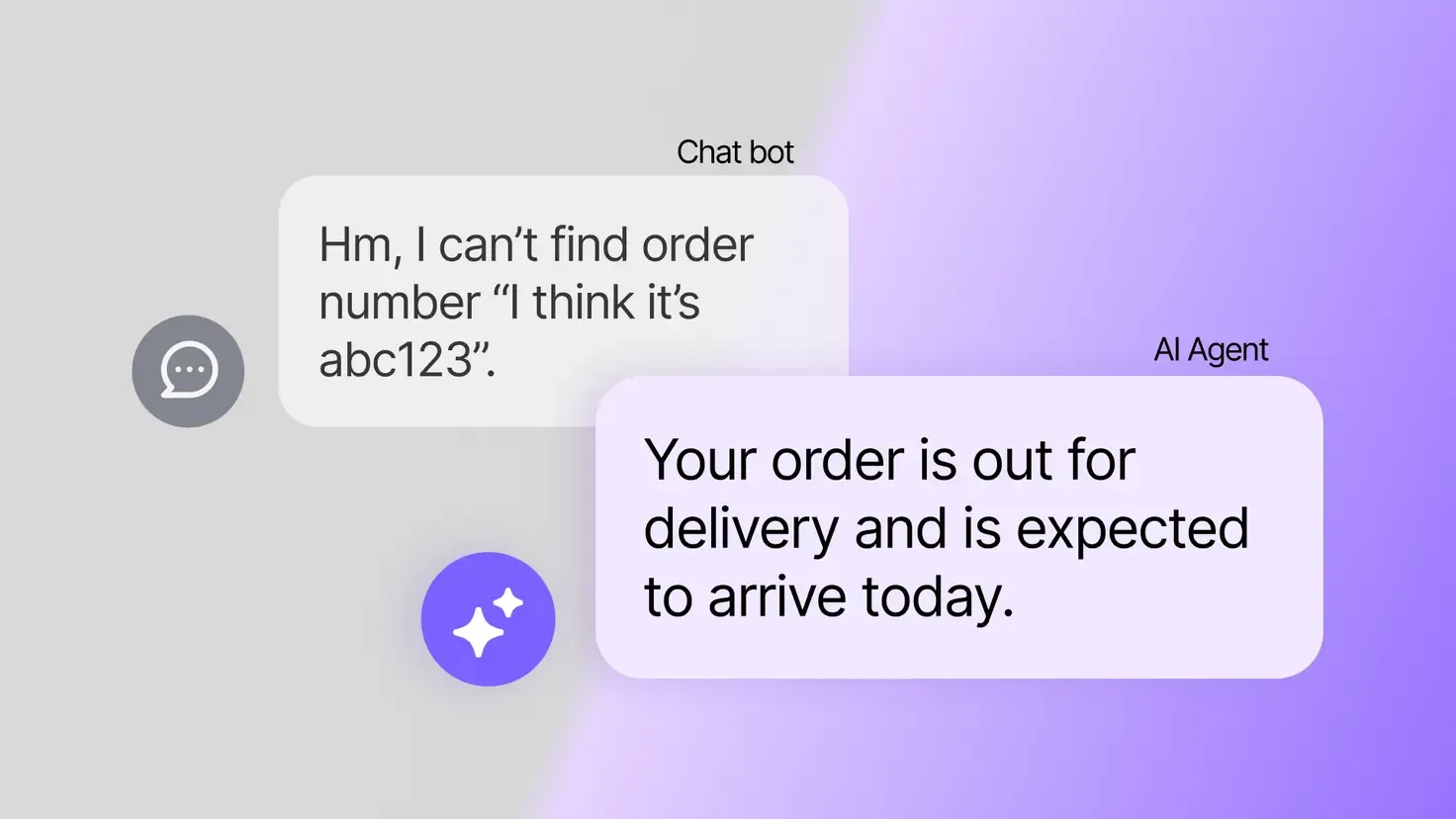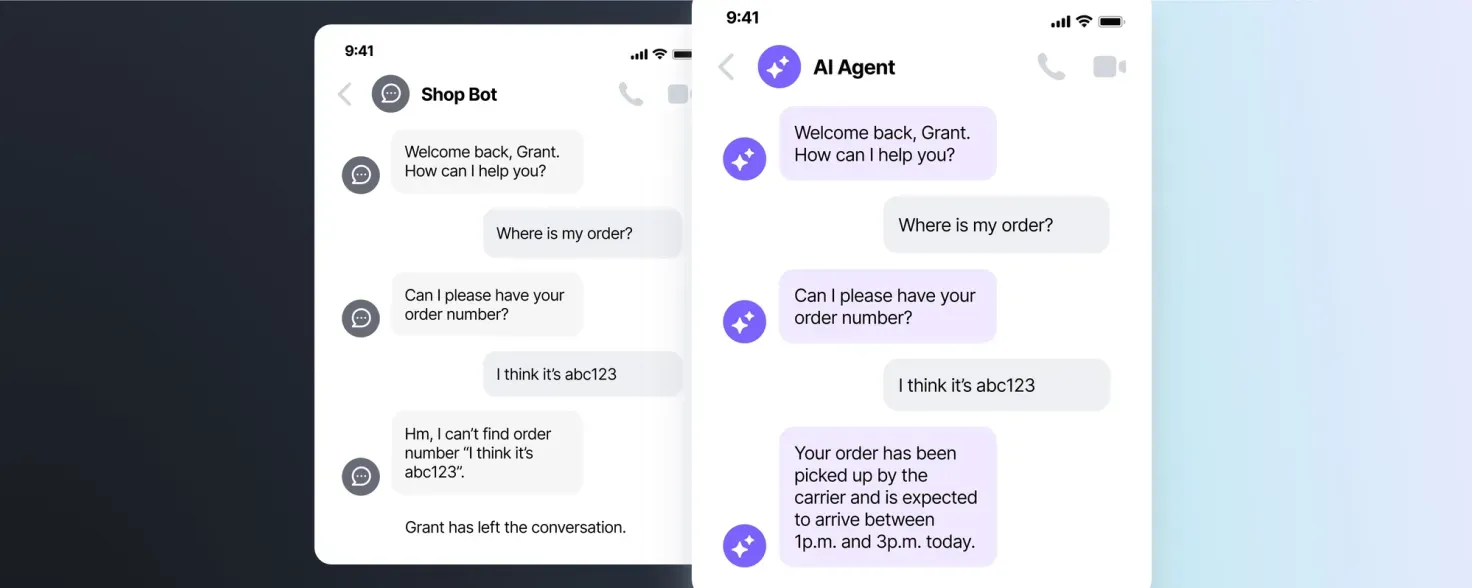
Guide to interviewing AI Agents
What makes an AI Agent different from the typical chatbots you’ve used in the past? Is the impact on ROI really that high?
Learn More

Using conversational AI for customer service can transform the customer experience. In fact, 77% of CEOs indicate that they will fundamentally change the way they engage and interact with customers, according to The Future of Customer Conversation report by Accenture.
“As a result, many organizations are turning to conversational artificial intelligence (AI) to meet communication demands, with the adoption of chatbots and conversational interfaces reaching unprecedented scale.”
- Accenture
Customers today expect quick responses and immersive experiences. And why shouldn’t they? All the top brands are offering them.
That’s exactly why using conversational AI in your customer service workflow is mission-critical. Conversational AI enables you to meet customer expectations with real-time, personalized responses to customer queries. Without conversational AI, you risk your reputation in a market that’s quickly implementing conversational AI across customer-facing processes.
Let’s dive deeper into the meaning of conversational AI and how it can transform customer service.
Conversational artificial intelligence (AI) is a group of technologies that enable computers to understand and respond to text and voice inputs that use natural language. Technologies like natural language processing (NLP) and machine learning algorithms allow machines to understand natural language and form responses based on the information from a specific database.
Here’s how NLP and machine learning, the two key conversational AI technologies, contribute to its functioning:
Customer service teams can use conversational AI to automatically resolve customer questions, perform account management tasks, and route customers to a team member when needed. The cost-saving potential is massive — conversational AI is expected to reduce contact center agent labor costs by $80 billion by 2026 .
"Conversational AI is expected to reduce contact center agent labor costs by $80 billion by 2026."
- Gartner
Don’t want to risk your reputation with slow responses? Here are three ways to implement conversational AI for customer service at your company.
Chatbots are applications that can auto-respond to customer queries. You can deploy chatbots on your website , mobile app, or social media messengers.
There are two categories of chatbots:

Given the current digital landscape and AI boom, customers expect a frictionless experience when interacting with a brand.
Conversational AI chatbots can help customers in two ways:
Voice assistants, like Google Assistant, Siri, and Alexa, use NLP and machine learning to understand speech and perform the boring, repetitive tasks in your workflow — “Alexa, add coffee to my shopping list”. Voice AI can automate call centers and enable customers to resolve their queries without ever speaking to a rep. The workflow is similar to chatbots, except that the machine first converts speech to machine-readable text.
If your customers have historically preferred reaching out via phone, using a conversational AI voice assistant for customer service can reduce the number of calls your service team has to handle. You can hand off most tasks to voice AI — identity verification, sharing invoice details with the customer, or providing information about your refund policy.
IVR systems help automate your phone system. When a customer calls, IVR greets them and offers them a list of options. Customers select an option using the keypad or a voice command. The caller can ask basic questions. They can request their bank balance when calling a bank or the amount due on their account when calling a supplier.
Conversational IVR systems are more advanced. They can steer conversations and respond to questions just like a human would. This natural conversation helps deliver a more enriched experience. Conversational IVRs can also respond to more complex questions, which helps reduce call traffic at your service desk.
If the system can’t answer the caller’s question, it can route the caller to the right person. The caller doesn’t have to jump from one rep to another, looking for the right person to speak to.
Customer service teams can use conversational AI to automate tasks at scale while still offering customers a personalized experience. If you’re curious about how conversational AI can help you improve customer service processes, consider the use cases below.
Intent detection involves analyzing the customer’s query and statements to understand the intent. This enables AI to offer more tailored responses and accurate information. When AI can’t offer relevant information, it collects information like the customer’s name and account number. It then routes the call to the right person on the customer service team with the relevant information.
You need to verify a customer’s identity when they reach out via your chatbot or voice assistant. Conversational AI can put authentication on autopilot so your customer service team never wastes time asking customers their date of birth and the name of their favorite high school teacher. AI-powered chatbots and voice assistants can authenticate customers using security questions or specific information, such as a keyphrase, just like a service rep.
When your customers need help using your product, they want quick solutions. Conversational AI helps users troubleshoot over chat or phone. It can understand the nuances of a customer’s problem and offer suggestions and helpful tips. The ability to understand natural language and generate personalized responses allows AI to resolve almost all queries independently.
Why invest in human agents in answering FAQs when your agents can work on more strategic projects? A chatbot or voice assistant can answer FAQs quickly and effectively. Unlike traditional chatbots, conversational AI chatbots can understand FAQs more accurately, even when a customer’s question doesn’t include the right keywords.
Account management tasks are best suited for self-service. Not only does that save agents’ time, it allows customers to be in control of their own accounts. Conversational AI can enable customers to create or delete an account, reset passwords, and integrate accounts.
When a customer requests a password reset via the chatbot or voice assistant, AI generates a response to guide the customer through the process. Thanks to conversational AI, the customer doesn’t need to use specific keywords like “reset.”
Multilingual support is an important use case for companies with international clients. If you have clients in markets with different languages, a conversational AI chatbot or voice assistant can answer customer questions in multiple languages. This allows you to scale support as you expand to new markets and deliver a more personalized experience, even to clients who don’t speak the same language as you.
From offering personalized responses to customer queries to automating the majority of your customer service workflow, conversation AI offers a broad range of benefits. As AI becomes more powerful, the role of customer service agents will evolve to focus on strategy and move away from repetitive tasks such as authentication and answering FAQs.
Here’s how you can benefit by implementing conversational AI in customer service.
Automating customer service tasks like answering FAQs, account management, and authentication allows the customer service team to focus on other strategic tasks. The time that automation saves your customer service team translates to a significant reduction in costs — Indigo saved over $150,000 in customer service staffing costs by using its “Instant Help” chatbot with Ada and project44’s lookup API.
58% of consumers think it’s important for companies to be reachable via live chat and expect a response within an hour. Conversational AI helps meet these expectations and even exceed them with quick and personalized responses.
71% of consumers consider personalized interactions a basic expectation, and 76% get frustrated when that doesn’t happen. Personalization is a crucial CX driver along with other factors like response speed and accurate answers. Conversational AI helps personalize responses to customer queries, improving customer experience.
"71% of consumers consider personalized interactions a basic expectation, and 76% get frustrated when that doesn’t happen."
- McKinsey & Company
Understaffing increases the risk of poor customer experience, and overstaffing is bad news for your bottom line. If you’ve hired temporary agents during peak season and then scaled back, you know how this process is tedious and expensive.
Conversational AI can handle thousands of customer queries over chat, email, social media, SMS, or phone, helping you avoid overstaffing during peak times. When business is slow, chatbots and voice assistants wait for queries to roll in without costing you a dime.
Conversational AI extracts valuable information when interacting with customers. It picks up on customer preferences and the most common issues your customers face. It uses this data to generate insightful reports that summarize key information with chatbot metrics like automated resolution rate, containment rate and CSAT, which help you make data-driven decisions.
Implementing a conversational AI solution requires investing time and money. Imagine spending all that time and money on a solution that doesn’t meet your needs. Save yourself the trouble and maximize your ROI by spending some time on research. Here are three factors to consider when choosing a conversational AI solution.
Automation platforms use training data to learn decision-making. Developers start by supplying conversational AI with a data set and making decisions based on the dataset. After basic training, you use a new data set to validate the results and test performance. An AI model that requires less training data to become proficient with your chosen utterances and intents can meet customer needs faster.
Accuracy is critical when addressing complex queries from customers. Ada's AI is optimized to ensure safety, accuracy, and relevance. Ada leads the industry with an F1 and accuracy score of 93.8 and 93.1, respectively. These scores prove Ada’s superiority when it comes to understanding your customers and generating quick and helpful responses.
Customer service teams often handle confidential information. When implementing conversational AI, security should be top of mind — just one security mishap can damage your reputation and result in a fine.
Top conversational AI solutions maintain strict compliance with global security and privacy standards. The top solutions protect confidential data with redactions in conversations and in the platform, single sign-on capability, and version history to track, audit, and undo changes. Ada meets GDPR and SOC2 regulations and maintains uptime with clear SLAs, ensuring a predictable interaction layer.
Integrations help exchange data between your conversational AI solution and other apps in your tech stack. Information exchange facilitates automation and personalization, allowing you to deliver excellent customer experience at scale.
For example, integrating Ada with Zendesk Sell, Salesforce, or Hubspot helps marketing and sales teams use these platforms as a central source of truth. They can pull customer data to offer personalized product recommendations and tailor-make content to improve customer experience.
Shapemint’s customer service team integrated Rachel Mint, a chatbot made in collaboration with Ada’s Automated Consumer Experience (ACX) Consultant, with Shopify and Zendesk. After Rachel Mint was deployed as the first line of support, Shapemint’s daily customer engagement increased by 15%, and live agent CSAT improved to an impressive 98%.
Conversational AI can supercharge your customer service workflow, but it can’t do customer service entirely by itself . Customer service agents must figure out ways to develop systems that effectively tap into AI’s capabilities to realize its true business value.
While conversational AI tools can do a lot of the heavy lifting, humans will need to contribute by setting up AI systems for success, actively managing them, and coaching them to get better with time . At Ada, we’re on a mission to build a solution that can resolve every customer interaction with AI, so you can focus on areas that require human touch.
Practical guides to evolve your team, strategy, and tech stack for an AI-first world.
Get the toolkit